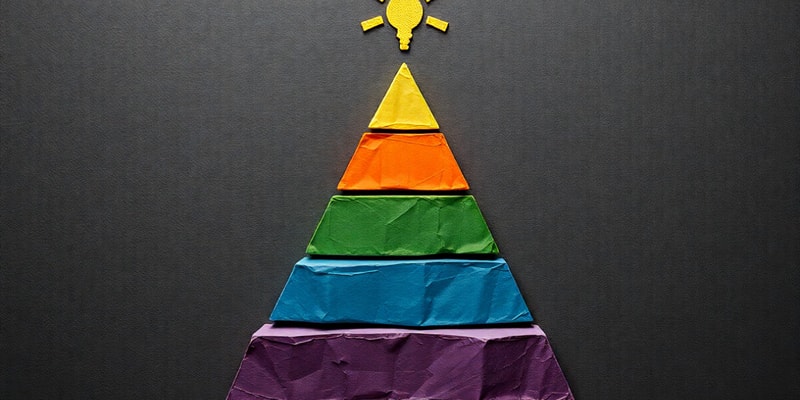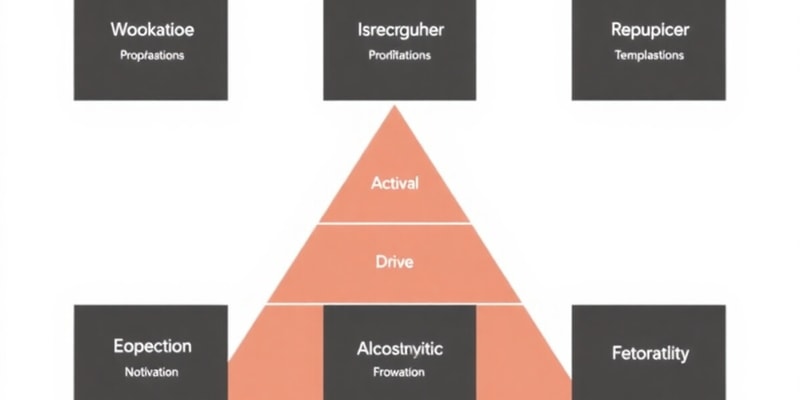Podcast
Questions and Answers
Which of the following best describes Maslow's Hierarchy of needs?
Which of the following best describes Maslow's Hierarchy of needs?
According to Drive-Reduction theory, what is the primary role of drives?
According to Drive-Reduction theory, what is the primary role of drives?
What is the primary purpose of a defense mechanism in psychology?
What is the primary purpose of a defense mechanism in psychology?
Which of the following is an example of the defense mechanism of projection?
Which of the following is an example of the defense mechanism of projection?
Signup and view all the answers
What distinguishes the Cannon-Bard theory from the James-Lange theory of emotion?
What distinguishes the Cannon-Bard theory from the James-Lange theory of emotion?
Signup and view all the answers
What is the relationship between stress appraisal and an individual's response to stress?
What is the relationship between stress appraisal and an individual's response to stress?
Signup and view all the answers
What are the two main traits assessed on the Eysenck Personality Scale?
What are the two main traits assessed on the Eysenck Personality Scale?
Signup and view all the answers
What is one primary benefit of aerobic exercise in relation to stress?
What is one primary benefit of aerobic exercise in relation to stress?
Signup and view all the answers
Study Notes
Motivation
- Motivation is the force that propels goal-directed behavior.
-
Drive-Reduction Theory:
- Needs are physiological requirements for survival (e.g., food, water, oxygen).
- Drives are an internal state of tension that motivates an organism to fulfill a need (e.g., hunger, thirst).
- Drive Reduction is the reduction in tension brought about by fulfilling a need which motivates behavior.
- Homeostasis is the tendency to maintain a balanced or constant internal state.
- Incentives are external motivating forces that pull an organism towards a goal (e.g., rewards).
-
Arousal Theory:
- Arousal is the physiological and psychological state of alertness.
- States that we are motivated to maintain an optimal level of arousal.
-
Maslow's Hierarchy of Needs:
- Basic (lowest level): Physiological needs (food, water, shelter, sleep).
- Highest Level: Self-actualization (achieving one's full potential).
- Self-actualization is the most important need according to Maslow.
-
Physiological effects of hunger:
- Increased stomach contractions and ghrelin levels.
- Decreased blood glucose levels.
- Ostracism is the social exclusion or rejection.
- James-Lange Theory of emotion: States that our physiological response to a stimulus comes before the emotion. We feel emotions because of our physiological responses.
- Cannon-Bard Theory of emotion: Proposes that physiological arousal and emotional experience occur simultaneously.
- Two-factor theory of emotion: States that we experience emotion based on our physiological arousal and cognitive interpretation of the situation.
- The Spillover effect refers to the tendency for our emotional state to influence our subsequent responses.
- Facial expressions of emotions are generally similar across cultures. However, there are some cultural variations in the specific display rules for emotions.
- Facial feedback effect: States that our facial expressions can influence our emotions. We can actually "feel" emotions by making the corresponding facial expressions.
Pessimism
- Pessimism is a negative outlook on life, characterized by expecting unfavorable outcomes.
- Personality is a unique and relatively stable pattern of thoughts, feelings, and behaviors.
- Freud’s Unconscious: Freud believed that the unconscious mind is a reservoir of thoughts, feelings, and memories that are not accessible to conscious awareness.
- Accessing the unconscious: Freud believed that we could access the unconscious through dreams, slips of the tongue, and free association.
- Dreams: Freud believed dreams were a symbolic expression of the unconscious.
- Free association: A technique in which individuals are encouraged to speak freely and spontaneously about whatever comes to mind.
-
Freud's psychoanalytic theory:
- Id: Primitive, instinctual part of the personality, driven by pleasure principle.
- Ego: The rational part of the personality, mediates between the id and superego, driven by the reality principle.
- Superego: The moral part of the personality, representing internalized societal values and standards.
-
Defense mechanisms are unconscious psychological strategies used to protect oneself from anxiety or unpleasant emotions.
- Projection: Attributing one's own unacceptable thoughts or feelings to another person.
- Displacement: Shifting one's emotions from an unacceptable target to a more acceptable one.
- Rorschach Inkblot Test: A personality assessment where individuals are asked to describe what they see in a series of inkblots.
Personality
- Eysenck Personality Scale: Assesses the personality dimensions of introversion-extraversion and neuroticism-stability.
-
Introversion: A personality trait characterized by:
- Quietude, solitude, and preference for internal world of thoughts and feelings.
-
Extroversion: A personality trait characterized by:
- Outspokenness, seeking external stimulation, and enjoyment of being around people.
-
BIG FIVE personality traits (CANOE):
- Conscientiousness: Responsible, organized, and dependable.
- Agreeableness: Cooperative, trusting, and helpful.
- Neuroticism: Prone to negative emotions, anxious, and emotionally unstable.
- Openness to experience: Curious, imaginative, and open to new ideas.
- Extraversion: Sociable, outgoing, and assertive.
Stress
- Stress is a state of mental or emotional strain or tension resulting from adverse or demanding circumstances.
- Stress reaction is the body's physiological response to stress.
-
Stress appraisal: The process of evaluating a situation to determine whether it is stressful or not, and how to cope with it.
- Appraisal: The way a person thinks about a situation.
- Stress Levels: This varies based on each individual's appraisal.
-
Stress management techniques:
- Exercise
- Relaxation techniques
- Mindfulness
- Social support
-
Benefits of aerobic exercise:
- Increases endorphin levels
- Reduces stress hormones
- Improves sleep
- Boosts mood.
-
Optimistic outlook:
- Helps us cope with stress more effectively by focusing on the positive aspects of a situation.
Studying That Suits You
Use AI to generate personalized quizzes and flashcards to suit your learning preferences.
Description
Explore the essential theories of motivation including Drive-Reduction Theory, Arousal Theory, and Maslow's Hierarchy of Needs. Understand how physiological needs, drives, incentives, and the pursuit of self-actualization influence human behavior. This quiz will enhance your grasp of motivational concepts vital for psychology.



